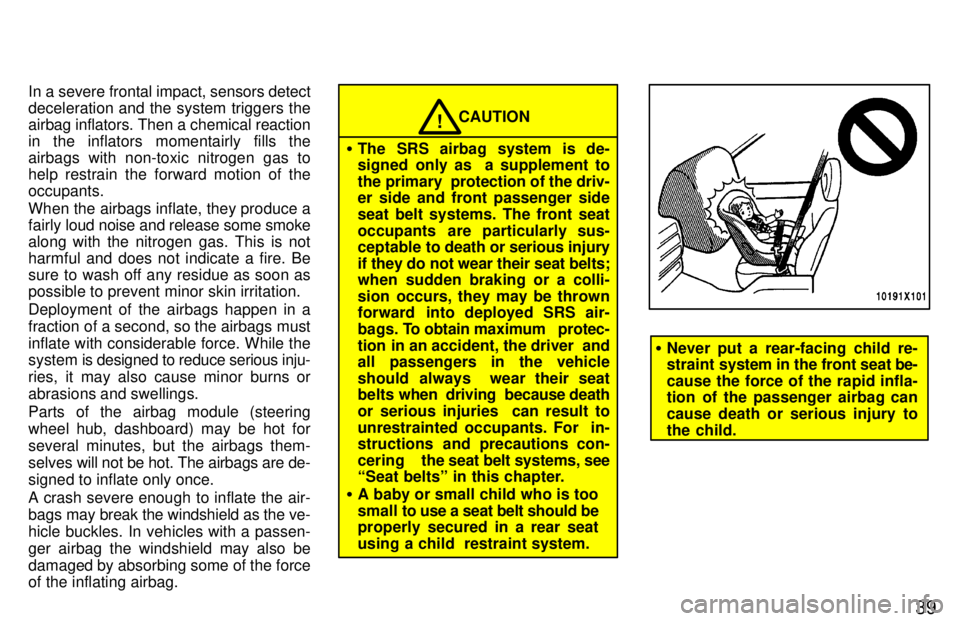Page 38 of 198

37
The SRS (Supplemental Restraint Sys-
tem) airbags are designed to provide
further protection to the driver and
front passenger when added to the pri-
mary protection provided by the seatbelts.
In response to a severe frontal impact, the
SRS airbags work together with the seat
belts to help preventing or reduce injury by
inflating, in order to decrease the likeli-
hood of the driver's or front passenger's
head or chest directly hitting the steering
wheel or dashboard. The passenger air-
bag is activated even with no passenger
in the front seat.This indicator comes on when the
ignition key is turned to the ACCº or
ONº position. It goes off after about 6
seconds. This means the SRS airbags
are operating properly.
The SRS airbag warning light system
monitors the airbag sensor assembly, in-
flators, warning light, interconnecting wir-
ing and power sources.The SRS airbag system is designeed
to activate in response to a severe
frontal impact within the shaded area
between the arrows in the illustration.
The SRS airbags will deploy if the severity
of the impact is above the designed
threshold level, comparable to an approxi-
mate 20 km/h (14 mph) collision when im-
pacting straight into a fixed barrier that
does not move or deform.
If the severity of the impact is below the
above threshold level, the SRS airbags
may not deploy.
SRS airbags
Page 40 of 198

39
In a severe frontal impact, sensors detect
deceleration and the system triggers the
airbag inflators. Then a chemical reaction
in the inflators momentairly fills the
airbags with non-toxic nitrogen gas to
help restrain the forward motion of theoccupants. When the airbags inflate, they produce a fairly
loud noise and release some smoke
along with the nitrogen gas. This is notharmful and does not indicate a fire. Be
sure to wash off any residue as soon as
possible to prevent minor skin irritation.
Deployment of the airbags happen in a
fraction of a second, so the airbags must
inflate with considerable force. While the
system is designed to reduce serious inju-
ries, it may also cause minor burns or
abrasions and swellings.
Parts of the airbag module (steering
wheel hub, dashboard) may be hot forseveral minutes, but the airbags them-selves w ill not be hot. The airbags are de-
signed to inflate only once.
A crash severe enough to inflate the air-
bags may break the windshield as the ve-
hicle buckles. In vehicles with a passen-ger airbag the windshield may also be
damaged by absorbing some of the force
of the inflating airbag.
CAUTION!
� The SRS airbag system is de-
signed only as a supplement to
the primary protection of the driv-
er side and front passenger side seat belt systems. The front seat
occupants are particularly sus-
ceptable to death or serious injury
if they do not wear their seat belts;
when sudden braking or a colli-
sion occurs, they may be thrown
forward into deployed SRS air-
bags. To obtain maximum protec-
tion in an accident, the driver and
all passengers in the vehicle
should always wear their seat
belts when driving because death
or serious injuries can result to
unrestrainted occupants. For in-
structions and precautions con-
cering the seat belt systems, see
Seat beltsº in this chapter.
� A baby or small child who is too
small to use a seat belt should be
properly secured in a rear seat
using a child restraint system.
�Never put a rear-facing child re-
straint system in the front seat be-
cause the force of the rapid infla-
tion of the passenger airbag can cause death or serious injury to
the child.
Page 76 of 198

74If this light comes on while you are driving,
slow
down and pull off the road. Stop the
vehicle at a safe place and put the selector
lever in pº. With the engine idling, wait
until the light goes off If the light goes off,
you can start the vehicle again. If the light
does not go off, call a Toyota dealer or
qualified repair shop for assistance.
NOTICE
Continued driving with the warning light on may damage the automatic
transmission.
(j) SRS Airbag Warning Light This light will come on when the igni-
tion key is turned to the ACCº or ONº
position. After about 6 seconds, the
light w ill go off. This means the airbag
system is operating properly.
The warning light system monitors the
front airbag sensors, center airbag sensor
assembly, inflators, warning light, inter-
connecting wiring and power sources.
If either of the following conditions occurs, this indicates a malfunction somewhere in the parts monitored by the warning light
system. Contact your Toyota dealer as
soon as possible to service the vehicle. �
The light does not come on when the
ignition key is turned to the ACCº or
ONº position or remains on.
� The light comes on while driving.
(k) Light Reminder Buzzer
This buzzer will sound if the driver's door is opened with the key removed from the
ignition switch and the headlight switch
left on. (l) Key Reminder Buzzer
This buzzer reminds you to remove the
key when you open the driver's door with the ignition key in the ACCº or LOCKº position.
CHECKING SERVICE REMINDER INDI-
CATORS (except the low fuel level
warning light)
1. Apply the parking brake.
2. Open one of the doors. The open door warning light should come on.
3. Close the door. The open door warning light should go
off.
4. Turn the ignition key to ACCº. The SRS airbag warning light should
come on. It goes off after about 6 sec-onds. 5. Turn the ignition key to ONº, but do
not start the engine.
All the service reminder indicators ex-
cept the open door warning light, SRS
airbag warning light and automatictransmission fluid temperature warn-
ing light should come on. The ABSº
warning light goes off after about 3 seconds.
6. Turn the ignition key to STARTº. The automatic transmission fluid tempera-
ture warning light should come on.
If any service reminder indicator or warn-
ing buzzer does not function as described above, either the bulb is burned out or the
circuit is in need of repair. Have it checked
by your Toyota dealer as soon as pos-sible.